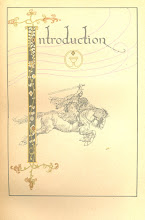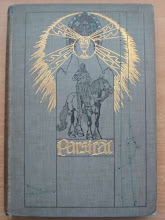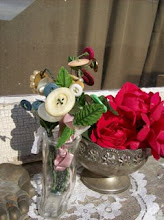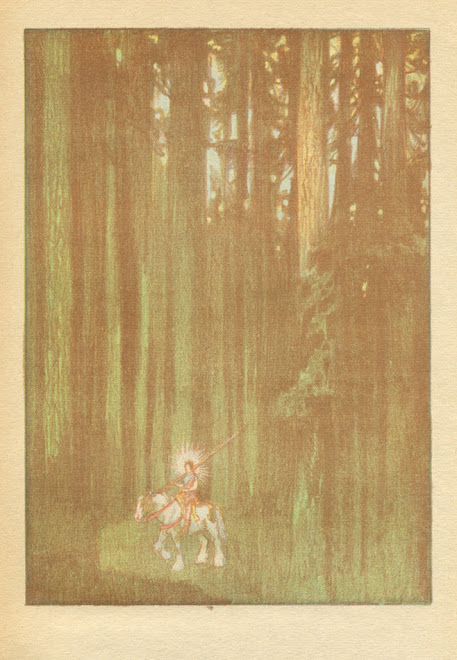There is a huge backstory to the process of writing my books. They started as scraps of poetry related to King Arthur material that I wrote back in 1998 or so, while I was living in New York City. I created several different notebooks labeled with the names of characters from the myth, and as I generated those scraps (and they really were scraps, some of them only two lines long), I filed them in the binders. They were handwritten scrawl, illegible to anyone but me, and mostly unconnected to each other, just germs of ideas. But I knew that I should record them, and that something might come of them eventually. They felt like seeds, almost pure potential. I had started writing shorter poems around 1992 or 1993, and songs followed starting in 1996. Before the King Arthur poems came, I started writing a play with music, its dialogue also in poetry, that I am working on to this day (art takes a long-term commitment, as you can see). The first King Arthur book that I seriously started was Parsifal, and I remember that I had taken a leather journal to the Laundromat with me one day to scribble in while I waited for my wash. It was a warm day in Manhattan, and I sat near the door, and started writing the section from the story where Parsifal meets the Fisher King. I had seen a picture recently that inspired me, of a handsome Roman-looking man in a forest, and that had been working on my subconscious. (Part of my creative process is to stimulate myself with images, and poetry and music often follows.) I started flowing words, lines and lines of poetry describing Parsifal as that black-haired man from the photo, following a stream through a dense forest. When he reached a pool, he found Anfortas sitting there on the rocks, casting his line. I continued writing as I waited for the laundry, and still kept going once I got home. I finished that section, and I completed several other sections, regarding Parsifal encountering the Grail for the first time in the chapel, and the knight following a path of white stones that looked like the Milky Way. I wasn’t sure where the symbolism was coming from, but I wrote it down anyway. I wrote bits and pieces for several weeks or months, and then it dried up for a very long time, and I did not go back to it, but stuck the pages into a battered white notebook and bided my time. In the meanwhile, years passed, and I worked on other projects, and started writing the volume about the life of Arthur one day on the Staten Island ferry. (Another thing about my creative process is that I don’t have the luxury of separating it from my daily life. It is completely interwoven with my daily activities, wherever I can grab some time for myself. It is not necessary to go on a retreat to write, all you need to do is to be disciplined and set aside some time. Even a little bit every day or week adds up.) It was again a pretty day, and the motion of the waves and the silvery color of the Verrazano Bridge stimulated my imagination, and I wrote the section of Arthur’s story where the barge from Avalon comes to retrieve him. I went home and sat on my thrift store couch all evening, writing pages and pages, maybe sixty or seventy handwritten pages in all. I was very happy with it, and kept working on that one for a while. Then, in late 2002, I went shopping in Soho, and bought a pretty green leather journal from a table on the street, near the Prince St. subway station. It was dark emerald in color and had an embossed fleur de lis on the cover. I took that home and put it on the coffee table with a lot of other knick knacks because I liked the way it looked in the jumble (my decorating style is Paris flea market meets charity shop with some dust thrown around for atmosphere). It sat there for a while, and suddenly one day that October, I picked it up and wrote the whole first section of The Flower of Knighthood:
“Upon a time of Christmastide / All Camelot gathered beside / The fire in the feasting hall. / Laughter rang up to the tall / And timbered ceiling of the room. / The sun’s return allowed no gloom. / Midwinter’s merried tales and singing / Mirrored hope the light was bringing. / In the home of heroes all / King Arthur gave a Christmas ball.”
I filled the journal and kept going. The color of the leather had reminded me of Sir Gawain and the Green Knight, which my book is based on, and I just got inspired by it. I had been very frustrated because I had started several projects but not been able to finish them. I had three large projects going at that point, and starting another instead of working on one of the ones already in progress made me crazy, but I have learned not to question such things and not to look a gift horse in the mouth when it comes to art. The thing about all of my projects, large and small alike, is that they are psychologically significant on a personal level, relevant to the time when they are created, and they are intimately connected to my environment. I can’t always finish something because other things need to happen first, to provide context or material. Another element of their creation is that as I write or compose or generate them by other means, they interact with my own nervous system development. As I write and finish larger pieces, my nervous system builds more internal connections and becomes more sophisticated, and as my nervous system realigns and matures itself through the work, the pieces become more cohesive. I can feel this happening, a sort of white light and warmth in my head, in the area of my crown chakra, and a growing sense of solidity in my body in general. The process is inner and outer; as Carl Jung calls it, alchemical. By projecting one’s inner contents into the work, one can refine both self and product in a lovely synergy. My books are also densely populated with detail and require a lot of research. That takes time, too. I synthesize things that I read and they make their way sooner or later into some kind of book or story or song.
I wrote fairly steadily on TFOK, and interjected that with one particularly long scene from Parsifal that I wrote one day, again on the ferry. I found the harbor very inspiring, and did a lot of writing on that commute. It was a section where Parsifal came to the sea, and I remember that it was a grey and chilly sort of day, and the feeling seeped into what I wrote. Suddenly Parsifal’s horse appeared. I had wanted to start an online literary journal named Parsifal’s Horse around 1999, but never really got it together to do so. I retained my notes for it, though, and never forgot about it, which is why I gave the name to this blog so much later. I was not personally cohesive enough at that time to follow through on that particular idea, but after years of applying myself to other works, I find that I am now capable of implementing the concept into reality, which makes me happy. His horse was suddenly in the scene, an augur of things to come, and I finished that part and put it with the other older material. Then that seemed to be over again for a while, and I went back to TFOK. I read Sir Gawain and Green Knight a large number of times, about sixty by the time I was done, in order to internalize the template of the story and its course of events. I modeled my book after it, with some major departures, but true to the source material in the story progression. I read it in several translations, and also in the original old English with a modern version side by side to it to get an idea of the thought patterns of its author. I had zero social life for most of that time, and certainly none during the time writing the bulk of Parsifal, which came later, after I moved to Los Angeles. I became a total hermit. I had wanted to make things, books and songs and what have you, for so long, and I was finally able to sustain myself long enough to do it, so nothing else seemed as important. I remember during the time writing TFOK, I worked a demanding day job and would finish that in the evenings, and then work on my book late into the night, until eleven, twelve o’clock, and then sleep and do it again. I often used to wake up in the middle of the night in NYC and find myself thinking lyrics or poems, and I would force myself to get up and write them down. You can always catch up on sleep, but you have to take inspiration when it comes. While writing Parsifal, I would often scribble in a notebook sitting on my bed with my head drooping down, barely conscious, and would finally go to bed when I just couldn’t make the pen move anymore. I also clearly remember once in New York hanging precariously off of the edge of my loft bed scratching out a song at 3 in the morning. I knew I was going to feel terrible when I had to get up at 7 to go to work, but it had to be done. You don’t refuse the sacred realm when it wants to give you the gift of creativity, no matter the cost. I have sacrificed a lot to make my books, and it’s been worth it, but the price has been very high. Their worth to me is very great for that reason; they have been very dearly earned.
I finished writing my first book, The Flower of Knighthood, in October of 2004, almost two years to the day after I started it. Somewhere in the process of writing it, I started a fourth one, The Engagement of Sir Gawain, still in progress at this time, along with the Arthur one and the unrelated play. I spent two years editing TFOK, then copyrighted it in August of 2006. I considered it ready for publication, and was starting to think about agents, publishers, etc. I also knew I needed to get back into one of my other older projects to prove to myself that I could finish another one. I had been through a lot personally – another reason I’ve taken a long time to finish projects is that some things have happened to me that took huge amounts of time and energy away from my creative life. I lived in NYC when 9-11 happened, and I lived in New Orleans when Katrina occurred, so I had a lot to occupy me that had nothing to do with art. I moved to Los Angeles a few months after I evacuated New Orleans, and once I had gotten a little settled, I copyrighted the first book and asked to be directed to the next project. I consider my art to be an opportunity to co-create the universe with God, and I take it as a sacred responsibility. I don’t rush into projects, and I don’t make them with a commercial eye. I let myself feel my way into what is right for me to explore and express. My personal experience of the divine is that God is Mind, including both conscious and unconscious aspects, and that that informs the Self, a sacred organization of the greater whole of existence into the particular and individual. The unconscious wellspring of the creative source will guide you to what you need if you let it, and that is what I did. I spent a huge amount of time researching random theological ideas and more King Arthur mythology. It all seemed unrelated at first, but one weekend I decided to go the Bay Area for a concert, and things started to coalesce to show me the path I needed to take. I drove to the show, and stopped to spend the night in Coalinga, CA. The next morning I woke up, and immediately started writing the first lines of Parsifal, which I had not touched in two or three years. I wrote for over an hour until it was time to go in order to make my concert in time. I sat on the grass at the outdoor venue and for the two days of the event, I wrote and wrote and wrote. I wrote so much that people around me asked me what I was doing. I wrote several sections unconnected to each other, and just let the work guide me. I went home to L.A. and wrote some more, took a break, and then over Thanksgiving weekend I locked myself into my room and wrote for four days straight, almost twelve hours a day. All of the seemingly random research I had done over the previous summer came together and the direction of the book revealed itself. I kept writing, and wrote more every single day until the following September, when I ran out of steam for about two weeks. By that time I had shaped at least two-thirds of the book, and had outlined the rest. I just got tired at that point, and I took the opportunity to catch up on other things. I did filing, made long-overdue phone calls, etc. Then I went to Hawaii for few days for a planned vacation, and being there was so beautiful and spiritual that I started writing again on the plane on the way home, and the momentum carried me all the way though to the end of the year. I had to sell my vehicle last summer because it was old and starting to break down, and I did not replace it. I wanted more time to write, and instead of sitting in traffic daily, I decided to spend my time working on my Parsifal morning and afternoon in order to bookend my day with creativity. That’s one reason I was able to speed up my pace so much. I opened up at least ten hours a week for writing time by sacrificing convenience for a while, which seems a fair trade to me. In the process of writing the bulk of the book, I went back to the older material, and found that I had progressed immeasurably as a writer. The earlier fragments had some usability, and I wove in what I could in order to keep the essence of the book’s beginnings, but I entirely jettisoned the original version of Parsifal’s encounter with the Grail in the chapel. It simply no longer worked in the newer framework. I also drastically rewrote the scene where the knight meets the Wounded King in the Grail forest. I used most of the older material, but I discovered that the older lines were in a different meter than the newer ones, and the language was more refined in my later work. I skipped over that part when I discovered the discrepancy, and it ended up being the very last part of the book that I wrote. When I came back to it, I sat down with my old notes on the bed beside me and the new book in my lap, and as I read the older part, I streamlined it into the newer one. I surprised myself with it. It frustrated me at first that I had to go back and fix that section when I was done with everything else, it seemed an annoyance, but as I worked I realized something very profound. That scene is at the very heart of the book, and of the myth itself. Parsifal is wounded in his male self-image, because his own father died before he was born. He finds a mirror in Anfortas, and their initial interaction is mysterious in a way that only poetry could convey. That’s why I write in the unusual form that I do – the material I am working with is so deep and so archetypal that only epic poetry can do it justice. That Arthurian sphere is truly the realm of the gods, where a holy cup is a living thing that can transform the world. By saving that part until the last, I linked the old version to the new and made a circuit of completion in the very middle of the book. The apple tree of Eden blossomed, Anfortas said some things I was not expecting to hear, and I cried when I finished it, because that scene made my book perfect.
I finished writing Parsifal, on December 31, 2007. I typed the last of the long-hand manuscript into a first draft about a month later, and am currently proofreading it. I also learned so much though writing this second book that I went back to The Flower of Knighthood and changed some things to match the style I had developed since it was completed in 2006. I wanted to bring it in line to match the newer work, as they are a series, and my writing improved during the last year and a half. Nothing major has been altered in the first one, just some turns of phrase and moving the narrative from more of a first-person perspective to a third-person one in a few places. I found that that shift takes the work out of my head more and places it in the real world, which is a very good thing. That’s why I write, is to engage with the world in a dynamic manner – information comes in, and I process it and relate it back, hopefully in a way that is helpful to others.
So now I have written two books, and that is how it happened. It’s taken ten years, two disasters, and an incalculable amount of hard work to get to this point. Maybe this account makes it clear why it’s so important to me that these books be published as I want them to be, without editing. They are by me and about me, from my soul’s interaction with God, and they chronicle my life and my deepest experiences, transcendently. There is absolutely no room for anyone else to get involved in their final form, because they are art, not mere writing and I am their sole expert. I hope I can find someone who understands that and will help me. And if I can’t, I’ll be that person for myself.
Tuesday, February 26, 2008
Subscribe to:
Post Comments (Atom)









No comments:
Post a Comment